Cognitive Radar Waveform Design Method under the Joint Constraints of Transmit Energy and Spectrum Bandwidth
Abstract
:1. Introduction
2. Closed-Loop CR Strategy
3. Waveform Design Method Signal Model and Problem Formulation
4. Joint Constraints Waveform Spectrum Design Algorithm and Time Synthesis Method
4.1. Joint Constraints Waveform Spectrum Design Algorithm
| Algorithm 1 Joint Constraints Waveform Spectrum Design |
| Input: , , , , Output: , , , e |
4.2. CM Sequence Synthesizing for Optimal Frequency Spectrum
| Algorithm 2 An iterative method for the time synthesis signal |
| Input: ϵ Output: ϕ
|
5. Experiments and Analysis
5.1. Experiment 1: Correct SINR Metric without Bandwidth Constraint
5.2. Experiment 2: Correct SINR Metric with Bandwidth Constraint
5.3. Experiment 3: ISL Metric of Waveform under Joint Constraints
5.4. Experiment 4: Relationships among the Transmit Energy, Bandwidth, and SINR
5.5. Experiment 5: Application of the Waveform Design Method to a Stationary Platform Using Real-Measured Data
5.6. Experiment 6: Application of Waveform Design Method in the Closed-Loop CR Strategy
6. Conclusions
Author Contributions
Funding
Data Availability Statement
Conflicts of Interest
References
- Gurbuz, S.Z.; Griffiths, H.D.; Charlish, A.; Rangaswamy, M.; Greco, M.S.; Bell, K. An Overview of Cognitive Radar: Past, Present, and Future. IEEE Aerosp. Electron. Syst. Mag. 2019, 34, 6–18. [Google Scholar] [CrossRef]
- He, H.; Li, J.; Stocia, P. Waveform Design for Active Sensing Systems: A Computational Approach; Cambridge University Press: Cambridge, UK, 2012. [Google Scholar]
- Aubry, A.; De Maio, A.; Jiang, B.; Zhang, S. Ambiguity function shaping for cognitive radar via complex quartic optimization. IEEE Trans. Sig. Process. 2013, 61, 5603–5619. [Google Scholar] [CrossRef]
- Bu, Y.; Yu, X.; Yang, J.; Fan, T.; Cui, G. A new approach for design of constant modulus discrete phase radar waveform with low WISL. Sig. Process. 2021, 187, 108145. [Google Scholar] [CrossRef]
- Song, J.; Babu, P.; Palomar, D.P. Sequence design to minimize the weighted integrated and peak sidelobe levels. IEEE Trans. Sig. Process. 2015, 64, 2051–2064. [Google Scholar] [CrossRef]
- Wu, L.; Babu, P.; Palomar, D.P. Cognitive radar-based sequence design via SINR maximization. IEEE Trans. Sig. Process. 2016, 65, 779–793. [Google Scholar] [CrossRef]
- Zhang, H.; Zhang, W.; Liu, Y.; Yang, W.; Yong, S. Scatterer-Level Time-Frequency-Frequency Rate Representation for Micro-Motion Identification. Remote Sens. 2023, 6615, 4917. [Google Scholar] [CrossRef]
- Zhang, H.; Tang, M.; Zhang, W.; Yang, W.; Jiang, W. Micro-motion Signal Enhancement via Convolutional Autoencoder Equipped with Multi-scale Feature Pyramid. In Proceedings of the 2023 8th International Conference on Signal and Image Processing (ICSIP), Wuxi, China, 8–10 July 2023; pp. 758–762. [Google Scholar]
- Wu, L.; Babu, P.; Palomar, D.P. Transmit waveform/receive filter design for MIMO radar with multiple waveform constraints. IEEE Trans. Sig. Process. 2017, 66, 1526–1540. [Google Scholar] [CrossRef]
- Zhao, L.; Sone, J.; Babu, P. A unified framework for low autocorrelation sequence design via majorization–minimization. IEEE Trans. Sig. Process. 2016, 65, 438–453. [Google Scholar] [CrossRef]
- Tang, B.; Naghsh, M.M.; Tang, J. Relative Entropy-Based Waveform Design for MIMO Radar Detection in the Presence of Clutter and Interference. IEEE Trans. Sig. Process. 2015, 63, 3783–3796. [Google Scholar] [CrossRef]
- Sun, Y.; Babu, P.; Palomar, D.P. Majorization-minimization algorithms in signal processing, communications, and machine learning. IEEE Trans. Sig. Process. 2016, 65, 794–816. [Google Scholar] [CrossRef]
- Zhou, K.; Quan, S.; Li, D.; Liu, T.; He, F.; Su, Y. Waveform and Filter Joint Design Method for Pulse Compression Sidelobe Reduction. IEEE Trans. Geosci. Remote Sens. 2022, 60, 1–15. [Google Scholar] [CrossRef]
- Li, Y.; Vorobyov, S.A. Fast Algorithms for Designing Unimodular Waveform(s) with Good Correlation Properties. IEEE Trans. Sig. Process. 2018, 66, 1197–1212. [Google Scholar] [CrossRef]
- Liang, J.; So, H.C.; Li, J. Unimodular sequence design based on alternating direction method of multipliers. IEEE Trans. Sig. Process. 2016, 64, 5367–5381. [Google Scholar] [CrossRef]
- Cheng, Z.; He, Z.; Zhang, S.; Li, J. Constant Modulus Waveform Design for MIMO Radar Transmit Beampattern. IEEE Trans. Sig. Process. 2017, 65, 4912–4923. [Google Scholar] [CrossRef]
- Yu, X.; Cui, G.; Yang, J.; Kong, L.; Li, J. Wideband MIMO Radar Waveform Design. IEEE Trans. Sig. Process. 2019, 67, 3487–3501. [Google Scholar] [CrossRef]
- Kerahroodi, M.A.; Aubry, A.; De Maio, A.; Naghsh, M.M.; Modarres-Hashemi, M. A Coordinate-Descent Framework to Design Low PSL/ISL Sequences. IEEE Trans. Sig. Process. 2017, 65, 5942–5956. [Google Scholar] [CrossRef]
- Alaee-Kerahroodi, M.; Modarres-Hashemi, M.; Naghsh, M.M. Designing Sets of Binary Sequences for MIMO Radar Systems. IEEE Trans. Sig. Process. 2019, 67, 3347–3360. [Google Scholar] [CrossRef]
- Aubry, A.; De Maio, A.; Govoni, M.A.; Martino, L. On the Design of Multi-Spectrally Constrained Constant Modulus Radar Signals. IEEE Trans. Sig. Process. 2020, 68, 2231–2243. [Google Scholar] [CrossRef]
- Liang, J.; So, H.C.; Li, J. Joint Design of the Receive Filter and Transmit Sequence for Active Sensing. IEEE Trans. Sig. Process. 2013, 20, 4707–4722. [Google Scholar]
- Liang, J.; So, H.C.; Li, J. A Max-min Fractional Quadratic Programming Framework with Applications in Signal and Information Processing. Sig. Process. 2019, 160, 1–12. [Google Scholar]
- Qiu, X.; Zhang, X.; Huo, K. Quartic Riemannian Adaptive Regularization with Cubics for Radar Waveform Design. IEEE Trans. Aerosp. Electron. Syst. 2023, 1–5. [Google Scholar] [CrossRef]
- Li, J.; Liao, G.; Huang, Y.; Zhang, Z.; Nehorai, A. Geometric Optimization Methods for Joint Design of Transmit Sequence and Receive Filter on MIMO Radar. IEEE Trans. Sig. Process. 2020, 68, 5602–5616. [Google Scholar] [CrossRef]
- Xu, C.; Wu, L.; Ciuonzo, D.; Wang, W. Joint Design of Horizontal and Vertical Polarization Waveforms for Polarimetric Radar via SINR Maximization. IEEE Trans. Aerosp. Electron. Syst. 2023, 59, 3313–3328. [Google Scholar]
- Qiu, X.; Jiang, W.; Zhang, X.; Huo, K.; Liu, Y. Joint Optimization Design Method for Cognitive MIMO Radar Transmit Waveform and Receive Filter. Syst. Eng. Electron. 2023, 45, 386–393. [Google Scholar]
- Aubry, A.; Carotenuto, V.; De Maio, A.; Farina, A.; Pallotta, L. Optimization Theory-based Radar Waveform Design for Spectrally Dense Environments. IEEE Aerosp. Electron. Syst. Mag. 2016, 31, 14–25. [Google Scholar] [CrossRef]
- Aubry, A.; De Maio, A.; Piezzo, M.; Farina, A. Radar Waveform Design in a Spectrally Crowded Environment Via Nonconvex Quadratic Optimization. IEEE Trans. Aerosp. Electron. Syst. 2014, 50, 1138–1152. [Google Scholar] [CrossRef]
- Tang, B.; Tang, J. Joint Design of Transmit Waveforms and Receive Filters for MIMO Radar Space Time Adaptive Processing. IEEE Trans. Sig. Process. 2016, 64, 386–393. [Google Scholar] [CrossRef]
- Qiu, X.; Jiang, W.; Zhang, X.; Huo, K. Quartic Riemannian Trust Region Algorithm for Cognitive Radar Ambiguity Function Shaping. IEEE Geosci. Remote Sens. Lett. 2022, 19, 4022005. [Google Scholar] [CrossRef]
- Friedlander, B. Waveform Design for MIMO Radars. IEEE Trans. Aerosp. Electron. Syst. 2007, 43, 1227–1238. [Google Scholar] [CrossRef]
- Pallotta, S.; Farina, A.; Smith, S.T.; Giunta, G. Phase-Only Space-Time Adaptive Processing. IEEE Access 2021, 9, 147250–147263. [Google Scholar] [CrossRef]
- Romero, R.A.; Bae, J.; Goodman, N.A. Theory and application of SNR and mutual information matched illumination waveforms. IEEE Trans. Aerosp. Electron. Syst. 2011, 47, 912–927. [Google Scholar] [CrossRef]
- Wang, Y.; Huang, G.; Li, W. Waveform design for radar and extended target in the environment of electronic warfare. J. Syst. Eng. Electron. 2018, 29, 48–57. [Google Scholar] [CrossRef]
- Kay, S. Optimal signal design for detection of gaussian point targets in stationary gaussian clutter/reverberation. IEEE J. Sel. Top. Sig. Process. 2007, 1, 31–41. [Google Scholar] [CrossRef]
- Bell, M.R. Information theory and radar waveform design. IEEE Trans. Inf. Theory 1993, 39, 1578–1597. [Google Scholar] [CrossRef]
- Zhao, D.; Yang, W.; Liu, Y. Spectrum Optimization Via FFT-based Conjugate Gradient Method for Unimodular Sequence Design. IEEE Trans. Aerosp. Electron. Syst. 2018, 142, 354–365. [Google Scholar] [CrossRef]
- Farina, A.; Maio, A.D.; Haykin, S.S. The Impact of Cognition on Radar Technology; IET: Stevenage, UK, 2017. [Google Scholar]
- Yu, R.; Yang, W.; Fu, Y.; Zhang, W.P. A Review on Cognitive Waveform Optimization for Different Radar Missions. Acta Electron. Sin. 2022, 50, 726–752. [Google Scholar]
- Oppenheim, A.V. Waveform Design for Active Sensing Systems: A Computational Approach; Prentice Hall International Inc.: New York, NY, USA, 1997. [Google Scholar]
- Woodward, P.M. Probability and Information Theory, with Applications to Radar: International Series of Monographs on Electronics and Instrumentation; Elsevier: Amsterdam, The Netherlands, 1964; Volume 3. [Google Scholar]
- Jackson, L.; Kay, S.; Vankayalapati, N. Iterative Method for Nonlinear FM Synthesis of Radar Signals. IEEE Trans. Aerosp. Electron. Syst. 2010, 46, 910–917. [Google Scholar] [CrossRef]
- Stoica, P.; He, H.; Li, J. New Algorithms for Designing Unimodular Sequences with Good Correlation Properties. IEEE Trans. Sig. Process. 2009, 57, 1415–1425. [Google Scholar] [CrossRef]

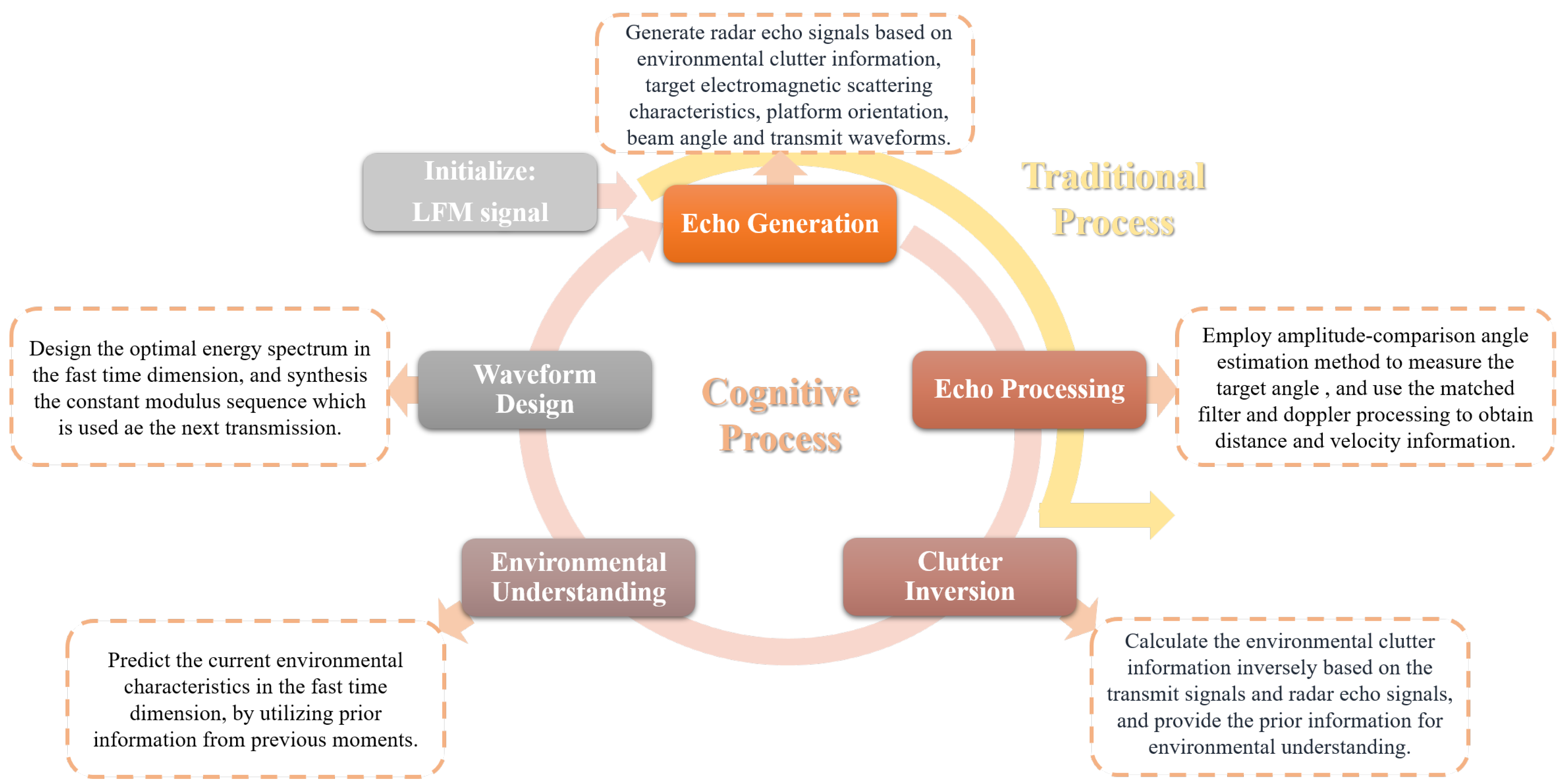


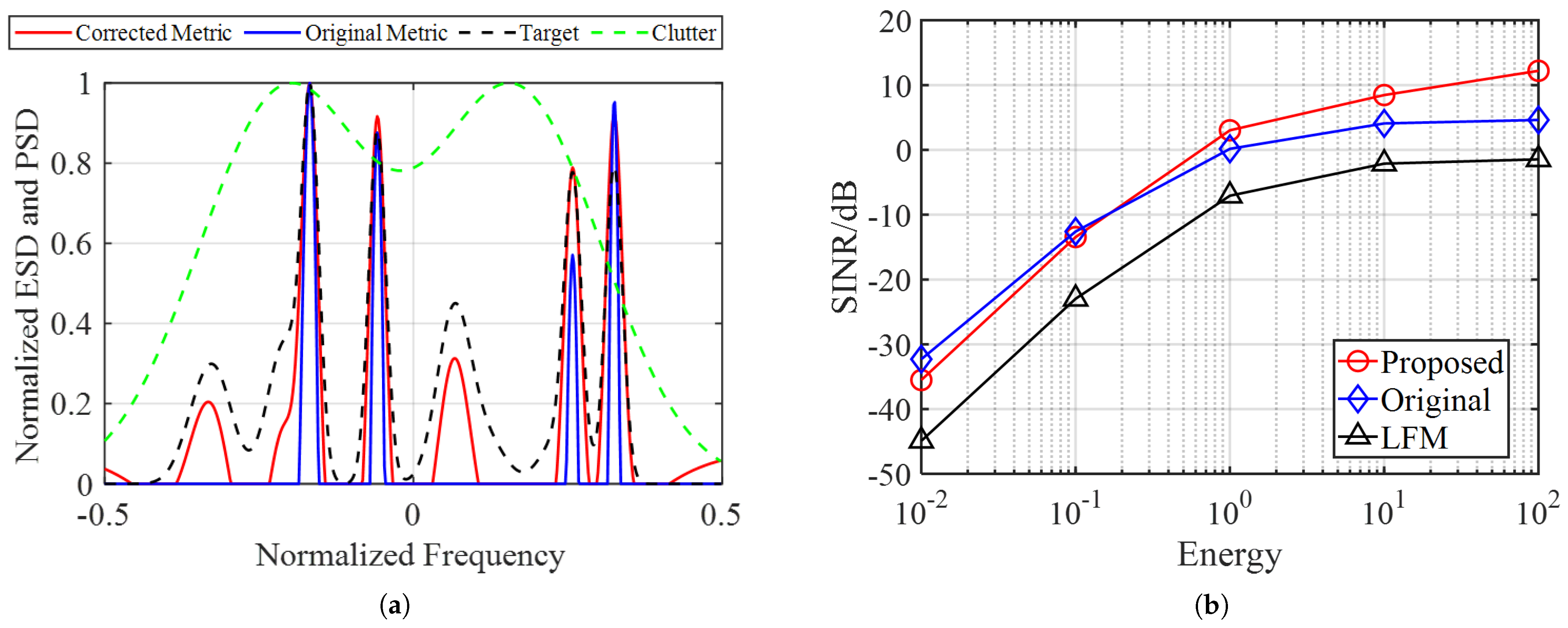
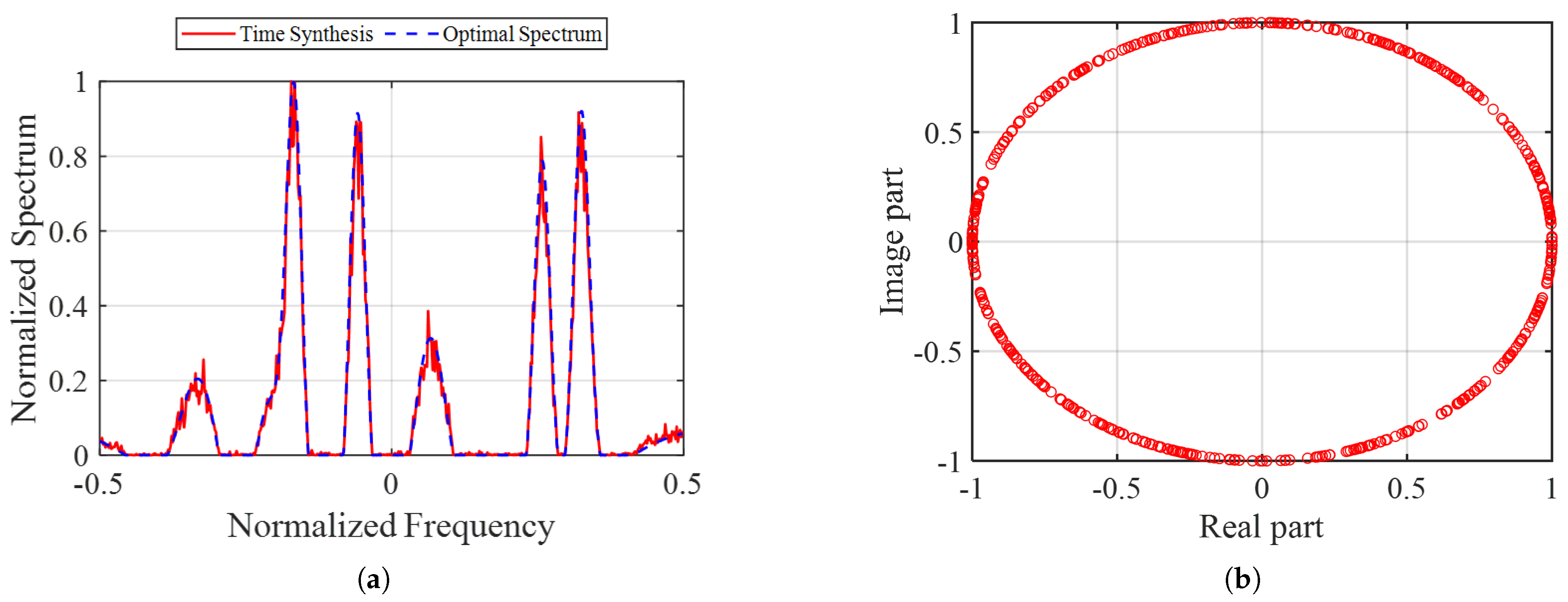

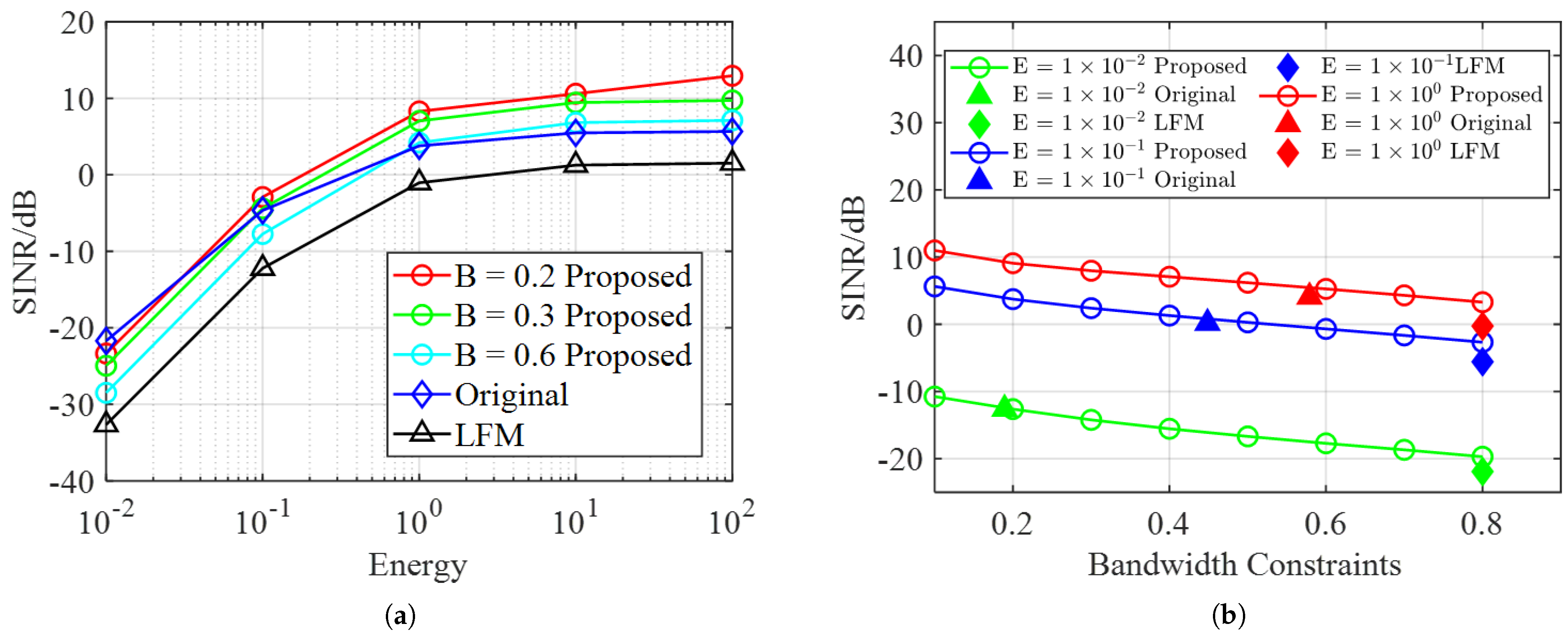
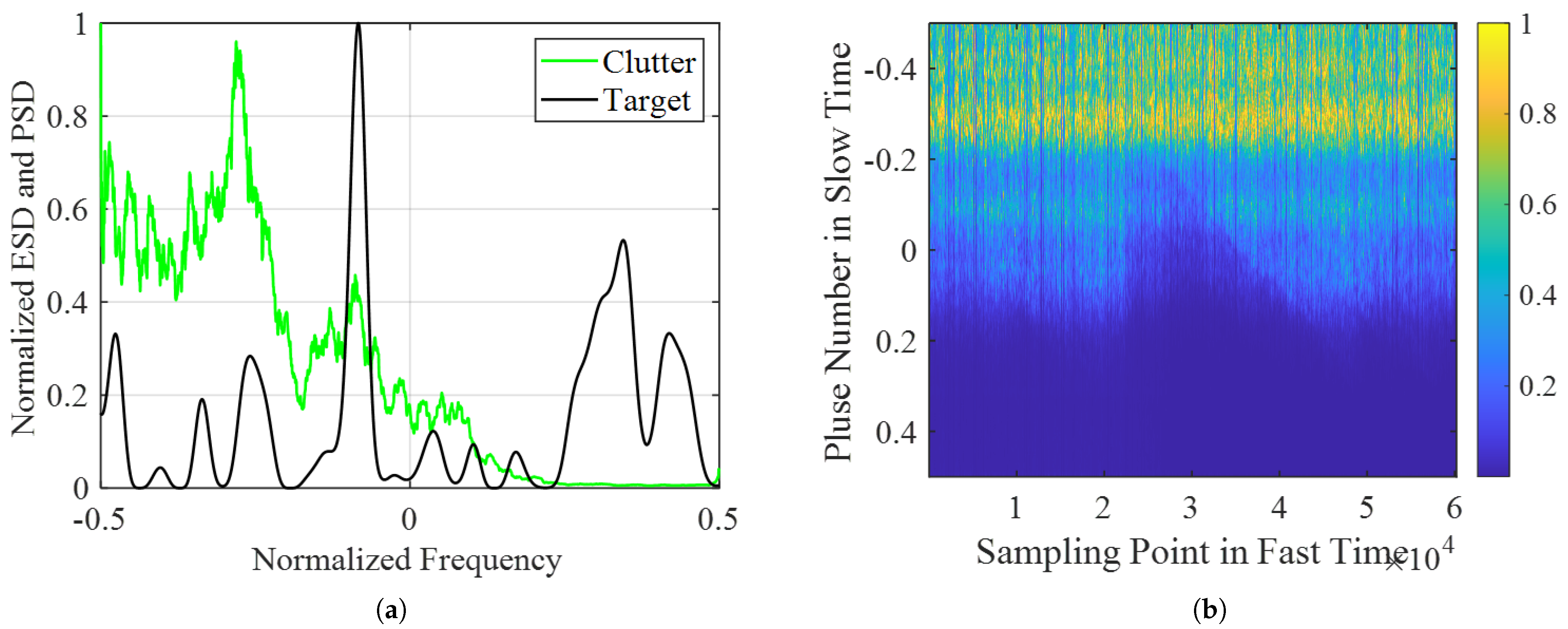
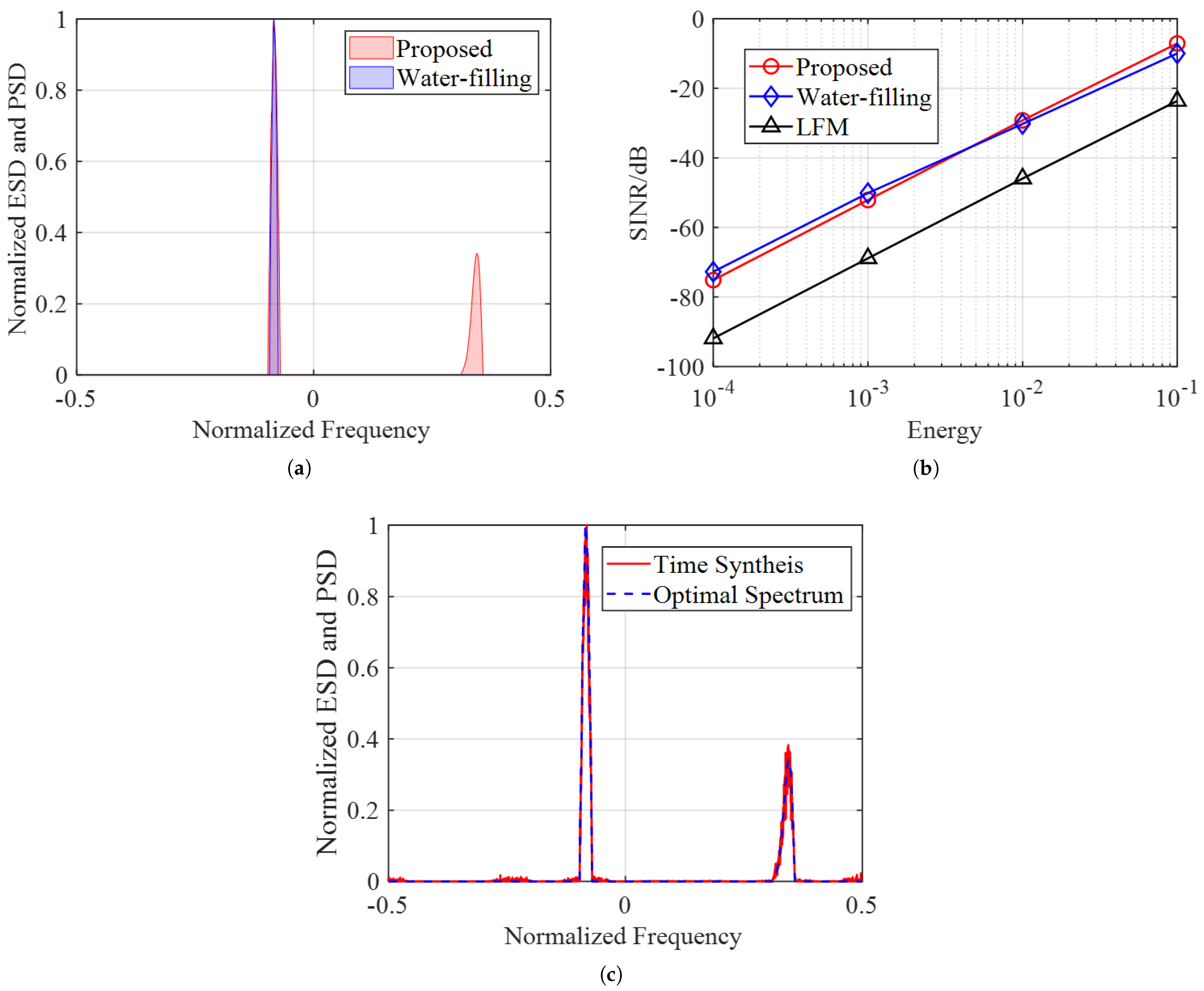
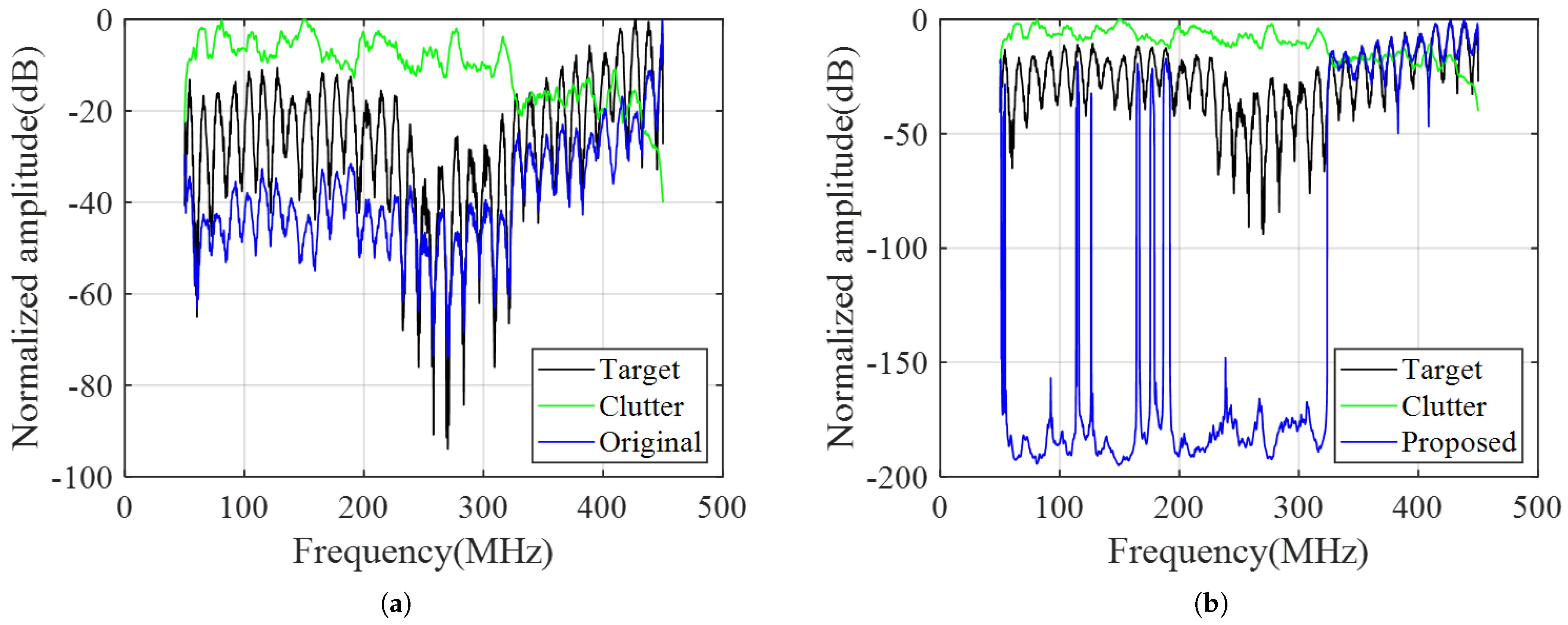


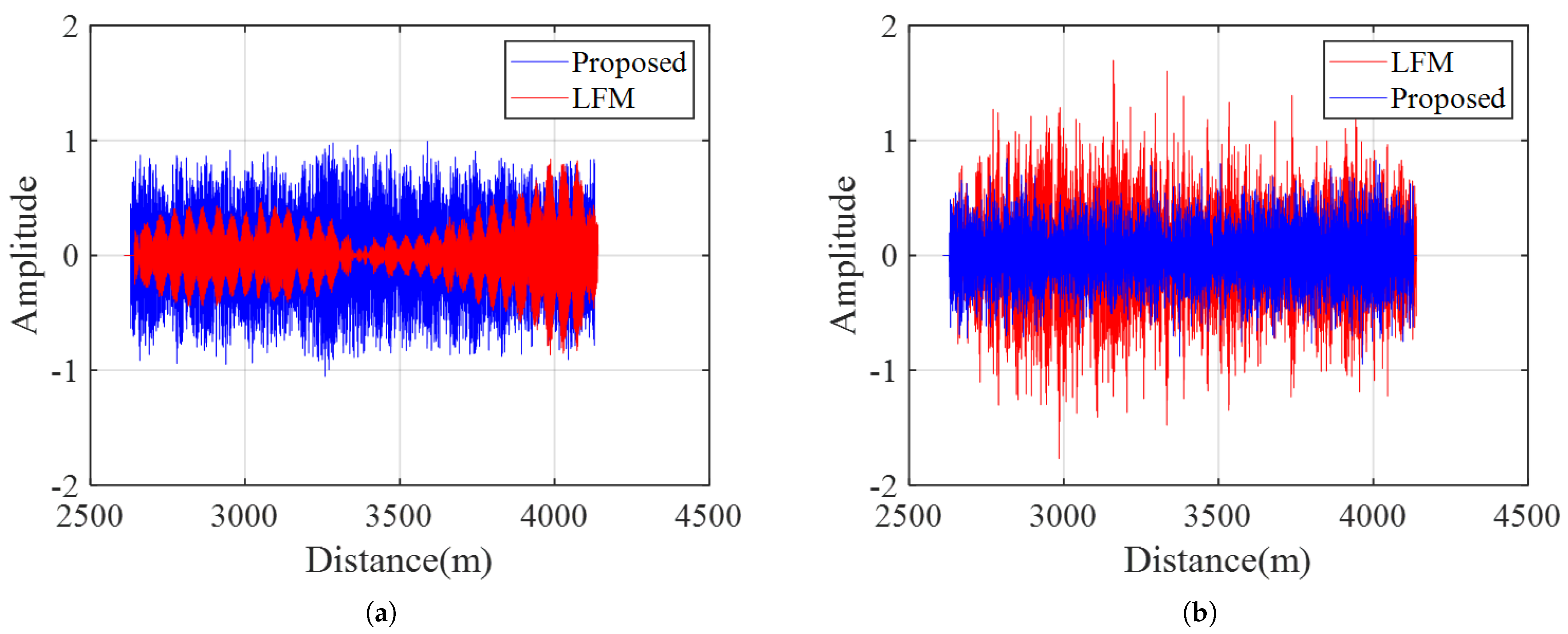
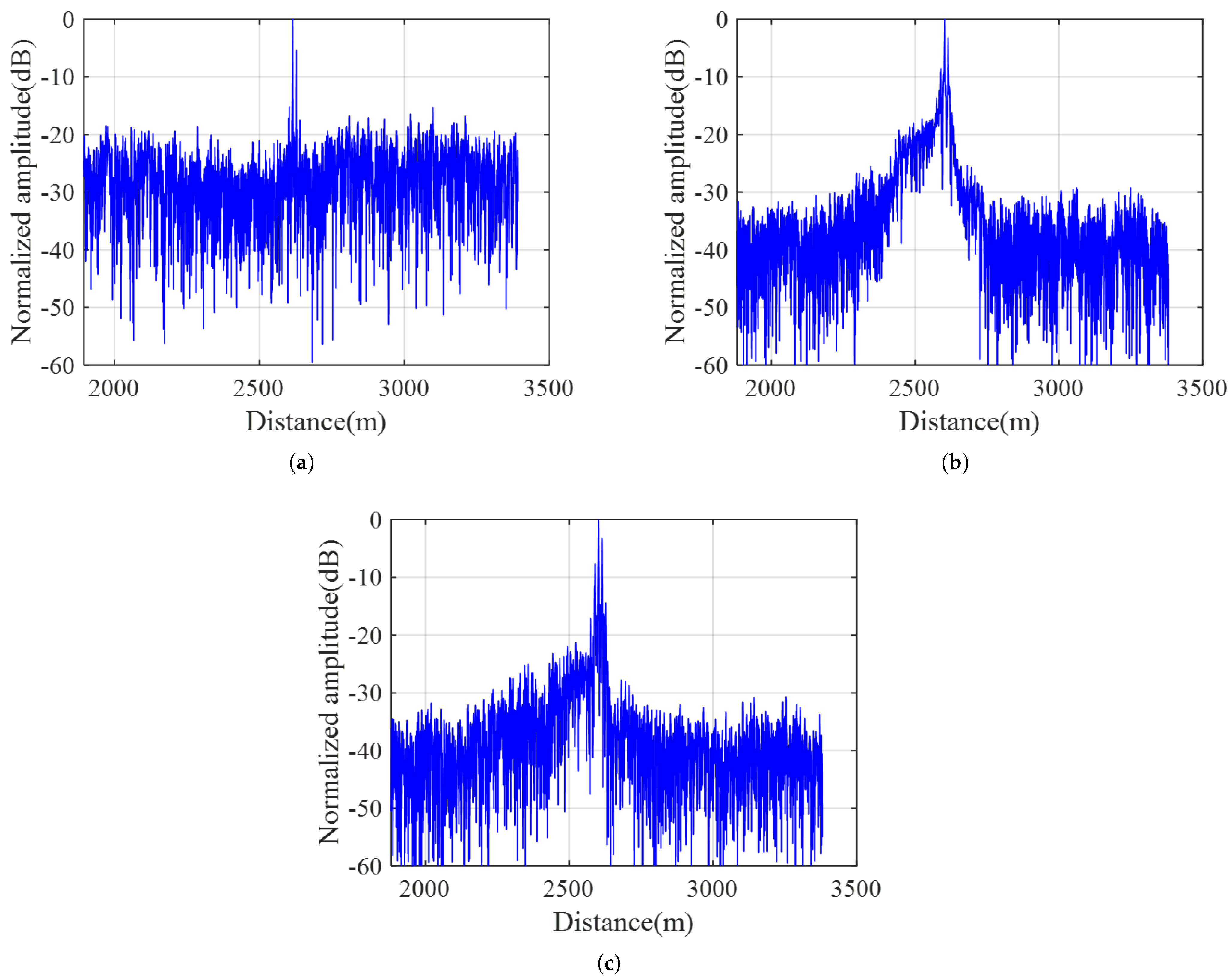
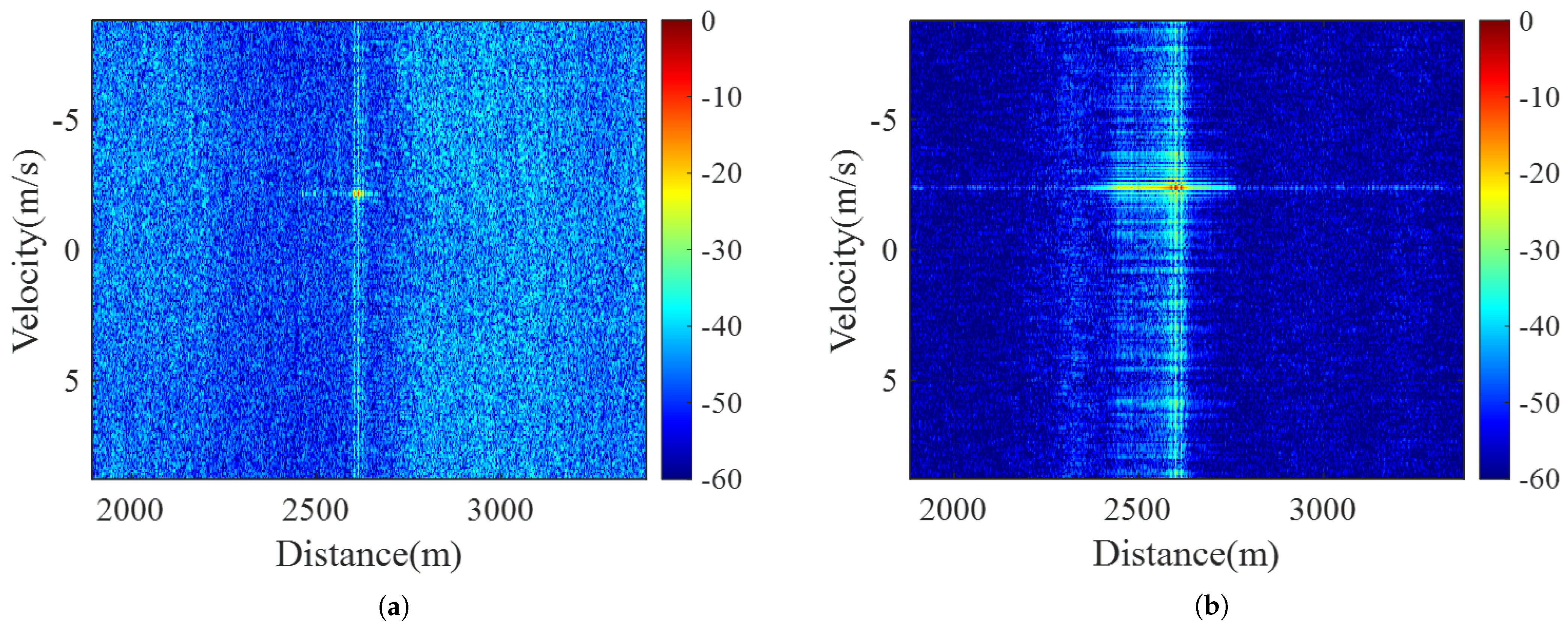
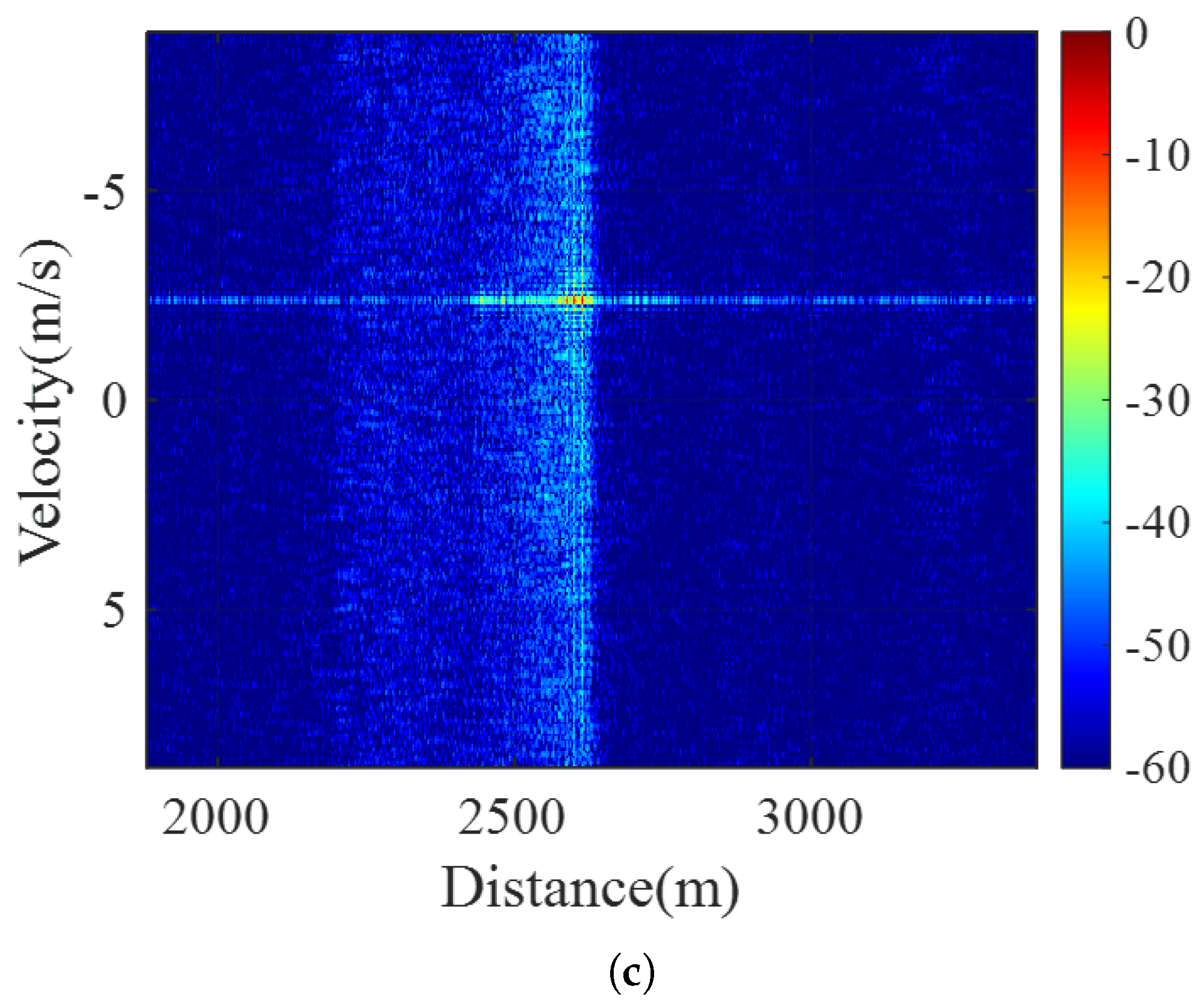
| Target Number | 1 | 2 | 3 | 4 | 5 | 6 | 7 | 8 | 9 | 10 |
|---|---|---|---|---|---|---|---|---|---|---|
| −0.42 | −0.38 | −0.25 | −0.2 | −0.07 | 0.08 | 0.15 | 0.28 | 0.31 | 0.39 | |
| 0.3 | 0.5 | 0.8 | 1 | 1 | 1 | 0.2 | 0.25 | 0.8 | 0.9 | |
| 1.70 × 10 | 1.70 × 10 | 1.70 × 10 | 8.00 × 10 | 8.00 × 10 | 1.70 × 10 | 1.70 × 10 | 1.70 × 10 | 8.00 × 10 | 8.00 × 10 |
| 0.1 | 0.25 | 0.5 | 0.8 | 0.9 | |
|---|---|---|---|---|---|
| Proposed | 0.10 | 0.26 | 0.59 | 1.40 | 2.10 |
| WF | 0.04 | 0.04 | 0.04 | 0.04 | 0.04 |
| Parameter | Value |
|---|---|
| Sampling Rate | 500 MHz |
| Bandwidth | 400 MHZ |
| Pulse Repetition Frequency (PRF) | 2000 Hz |
| Pulse Width | 10 s |
| Height | 1.5 km |
| Pitch Angle | |
| Azimuth Angle | |
| Polarization Mode | HH |
| Distance Sampling Interval | 0.3 m |
Disclaimer/Publisher’s Note: The statements, opinions and data contained in all publications are solely those of the individual author(s) and contributor(s) and not of MDPI and/or the editor(s). MDPI and/or the editor(s) disclaim responsibility for any injury to people or property resulting from any ideas, methods, instructions or products referred to in the content. |
© 2023 by the authors. Licensee MDPI, Basel, Switzerland. This article is an open access article distributed under the terms and conditions of the Creative Commons Attribution (CC BY) license (https://creativecommons.org/licenses/by/4.0/).
Share and Cite
Yang, C.; Yang, W.; Qiu, X.; Zhang, W.; Lu, Z.; Jiang, W. Cognitive Radar Waveform Design Method under the Joint Constraints of Transmit Energy and Spectrum Bandwidth. Remote Sens. 2023, 15, 5187. https://doi.org/10.3390/rs15215187
Yang C, Yang W, Qiu X, Zhang W, Lu Z, Jiang W. Cognitive Radar Waveform Design Method under the Joint Constraints of Transmit Energy and Spectrum Bandwidth. Remote Sensing. 2023; 15(21):5187. https://doi.org/10.3390/rs15215187
Chicago/Turabian StyleYang, Chen, Wei Yang, Xiangfeng Qiu, Wenpeng Zhang, Zhejun Lu, and Weidong Jiang. 2023. "Cognitive Radar Waveform Design Method under the Joint Constraints of Transmit Energy and Spectrum Bandwidth" Remote Sensing 15, no. 21: 5187. https://doi.org/10.3390/rs15215187
APA StyleYang, C., Yang, W., Qiu, X., Zhang, W., Lu, Z., & Jiang, W. (2023). Cognitive Radar Waveform Design Method under the Joint Constraints of Transmit Energy and Spectrum Bandwidth. Remote Sensing, 15(21), 5187. https://doi.org/10.3390/rs15215187






